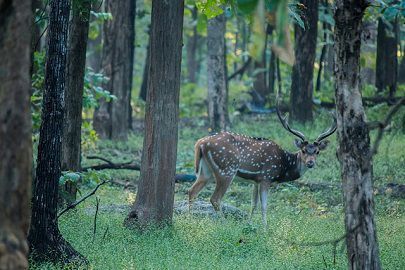Know the Difference between Wildlife Sanctuaries and National Parks
Context
-
Wildlife Sanctuaries and National Parks are protected natural habitats, declared by the government of a country according to the regulations from the IUCN (The World Conservation Union) to preserve the wildlife through the conservation of ecosystems. It is important to understand difference between Wildlife Sanctuaries and National Parks.

Image Source: Key Differences
Wildlife (Protection) Act, 1972
- The Wildlife (Protection) Act, 1972 provides for the establishment of Protected Areas in India. There are different categories of protected areas which are managed with different objectives for the larger motive of conservation.
- There are 104 National Parks in India. The first national park in India was established as Hailey National Park in the year 1936 and later renamed as Corbett National Park. The Government of India enacted the Wildlife Protection Act in 1972 with the aim to effectively protect the wildlife of the country and control poaching, smuggling, and illegal trade in wildlife.
About Wildlife Sanctuaries and National Parks
National Parks
- National parks provide protection to the entire ecosystem, that is, flora, fauna, landscape, etc. of that region. The national parks not only conserve wildlife but also provide a diversion of environmental and landscape heritage in a manner that does not harm it, in order to provide enjoyment to future generations.
- National parks are given a greater degree of protection, with human activity greatly restricted.
- Only certain areas can be visited and only activities permitted by the chief wildlife warden of the state are allowed in the park.
- These protected areas are established by central and state governments for the conservation of wild animals and for the purpose of propagating or developing nature.
Wildlife Sanctuaries
- Wildlife Sanctuary, as the name implies, is the place that is reserved exclusively for wildlife use, which includes animals, reptiles, insects, birds, etc. wild animals, especially those in danger of extinction and the rare ones, so that they can live in peace for a lifetime and keep their population viable.
- Wildlife is the main natural heritage, worldwide. Continuous industrialisation and deforestation have posed a threat of extinction to wildlife.
- Wildlife sanctuaries refer to an area that provides protection and living conditions favorable to wild animals. India has 553 wildlife sanctuaries.
Biosphere Reserve
- Biosphere reserves are protected large areas of natural habitat, that includes a Wildlife Sanctuaries and National Parks. There are around 18 biosphere reserves in India, created to demonstrate a balanced relationship between people and nature.
Key Facts: India is one of the 17 megadiverse countries of the world. With only 2.4% of the world’s land area, 16.7% of the world’s human population and 18% livestock, it contributes about 8% of the known global biodiversity.
Note: The Indian Constitution entails the subject of forests and wildlife in the Concurrent list thus laying the responsibility of wildlife conservation on both the Centre and the State.
Basics Difference between Wildlife Sanctuaries and National Parks
| Wildlife Sanctuaries | National Parks |
|---|---|
| It is a natural protected habitat which provides protection and favourable living conditions to wildlife including the rare or endangered species of plants, animals, insects etc. | It is an area of land protected by the national government to conserve its entire ecosystem like its natural beauty along with the wildlife. |
| It mainly provides protection to birds, animals, insects, reptiles and other organisms. | It protects the entire ecosystem of the land plants, animals, landscapes, historic objects etc. |
| It is not a highly restricted area, limited human activities are allowed. | It is a highly restricted area, human activities are not allowed. |
| It does not have visible or marked boundaries. | It has clearly marked boundaries. |
| It can be owned by government or a private organization. | It is owned by the government only. |
| It is an IUCN category IV protected area. | It is an IUCN category II protected area. |
Important Wildlife Sanctuaries and National Parks
| Name of the Sanctuary/National Park | Location |
|---|---|
| Kaziranga National Park* | Jorhat (Assam) |
| Manas Tiger Sanctuary* | Barpeta (Assam) |
| Keoladeo National Park* | Bharatpur (Rajasthan) |
| Sundarbans Tiger Sanctuary* | 24 Paraganas (West Bengal) |
| Bandhavgarh National Park | Shahdol (Madhya Pradesh) |
| Kanha National Park | Mandla ( Madhya Pradesh) |
| Dudwa National Park | Lakhimpur, Kheri (Uttar Pradesh) |
| Chandraprabha Sanctuary | Varanasi (Uttar Pradesh) |
| Corbett National Park | Nainital (Uttarakhand) |
| Rajaji National Park | Dehradun, Haridwar, Pauri Garhwal (Uttarakhand) |
| Dachigam National Park | Srinagar (Jammu & Kashmir) |
| Ranthambore Tiger Sanctuary | Sawai Madhopur (Rajasthan) |
| Ghatprabha Bird Sanctuary | Belgaum (Karnataka) |
| Bandipur National Park | Mysore (Karnataka) |
| Gir National Park | Junagarh (Gujarat) |
| Nal Sarovar Bird Sanctuary | Ahmedabad (Gujarat) |
| Hazaribagh National Park | Hazaribagh (Jharkhand) |
| Nelapattu Bird Sanctuary | Nellore (Andhra Pradesh) |
| Mudumalai Sanctuary | Nilgiris (Tamilnadu) |
| Periyar Sanctuary | Idduki (Kerala) |
| Simlipal Tiger Sanctuary | Mayurbhanj (Odisha) |
| Gahirmatha Turtle Sanctuary | Kendrapara (Odisha) |
| Vikramshila Gangetic Dolphin Sanctuary | Bhagalpur (Bihar) |
| Silent Valley National Park | Palakkad, (Kerala) |
| Rani Jhansi Marine National Park | Andaman & Nicobar Islands |
| Campbell National Park | Andaman & Nicobar Islands |
| Galathea National Park | Andaman & Nicobar Islands |
| Mahatma Gandhi Marine National Park | Andaman & Nicobar Islands |
Source: IndiaToday & Javapoint
For More Such Biodiversity & Environment Topics: Click Here
